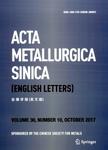Microstructure Evolution and Pore Formation Mechanism of Porous TiAl3 Intermetallics via Reactive Sintering
Microstructure Evolution and Pore Formation Mechanism of Porous TiAl_3 Intermetallics via Reactive Sintering作者机构:School of Materials Science and EngineeringChina University of Mining and TechnologyXuzhou 221116People's Republic of China School of Chemical Engineering and TechnologyChina University of Mining and TechnologyXuzhou 221116People's Republic of China State Key Laboratory for Advanced Metals and MaterialsUniversity of Science and Technology BeijingBeijing100083People's Republic of China Division of Materials ScienceLulefi University of Technology97187 LulJtSweden
出 版 物:《Acta Metallurgica Sinica(English Letters)》 (金属学报(英文版))
年 卷 期:2018年第31卷第4期
页 面:440-448页
核心收录:
学科分类:08[工学] 080502[工学-材料学] 0805[工学-材料科学与工程(可授工学、理学学位)]
基 金:supported by the Fundamental Research Funds for the Central Universities(2017XKQY006)
主 题:Intermetallics Porous materials Powder metallurgy Reaction synthesis Thermal explosionsynthesis
摘 要:Porous TiAl3 intermetallics were fabricated through vacuum reactive sintering from Ti-75A1 at.% elemental powder *** phase compositions,expansion behaviors,pore characteristics and microstructure evolution of TiAl3 intermetallics were investigated,and the pore formation mechanism was also *** was found that the actual temperature of compacts showed an acute climb from 668 to 1244℃ in 166s,while the furnace temperature maintained the linear growth of 5℃/min,which indicated that an obvious thermal explosion(TE)reaction occurred during sintering,and only single-phase TiA13 intermetallic was synthesized in TE *** open porosity increased from 22.2(green compact)to 32.8% after reactive diffusion sintering at 600℃ and rised to 58.7% after TE,then decreased to 51.2% after high-temperature homogenization at 1100℃.Therefore,TE reaction is the dominated pore formation mechanism of porous TiAl3 *** pore evolution in porous TiAl3 intermetallics occurred by the following mechanisms:certain intergranular pores remained among powder particles of green compact,then low-temperature sintering resulted in a further increase in porosity due to the Kirkendall ***,TE reaction gave rise to a dramatic volume expansion because of the rapid increase in temperature,and high-temperature sintering caused densification and a slight shrinkage.



